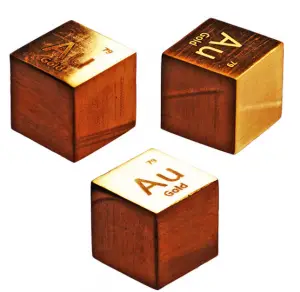This article contains comparison of key thermal and atomic properties of nickel and gold, two comparable chemical elements from the periodic table. It also contains basic descriptions and applications of both elements. Nickel vs Gold.

Nickel and Gold – About Elements


Source: www.luciteria.com
Nickel and Gold – Applications
Nickel
The global production of nickel is presently used as follows: 68% in stainless steel; 10% in nonferrous alloys; 9% in electroplating; 7% in alloy steel; 3% in foundries; and 4% other uses (including batteries). Nickel is used as a constituent of different types of alloys; for instance, Monel (corrosion resistant material), Nichrome (an alloy used for resistance heating elements), Permalloy (an alloy with high magnetic permeability at low field strength and low hysteresis loss), cupro-nickel, stainless steel, nickel silver, etc. Nickel based alloys (e.g. Fe-Cr-Ni(Mo) alloys) alloys exhibit excellent ductility and toughness, even at high strength levels and these properties are retained up to low temperatures. Nickel and its alloys are highly resistant to corrosion in many environments, especially those that are basic (alkaline). Nickel also reduces thermal expansion for better dimensional stability. Nickel is the base element for superalloys. These metals have excellent resistance to thermal creep deformation and retain their stiffness, strength, toughness and dimensional stability at temperatures much higher than the other aerospace structural materials.
Gold
Gold is used extensively in jewellery, either in its pure form or as an alloy. About 75% of all gold produced is used in the jewelry industry. Pure gold is too soft to stand up to the stresses applied to many jewelry items. Craftsmen learned that alloying gold with other metals such as copper, silver, and platinum would increase its durability. The term ‘carat’ indicates the amount of gold present in an alloy. 24-carat is pure gold, but it is very soft. 18- and 9-carat gold alloys are commonly used because they are more durable. Gold’s high malleability, ductility, resistance to corrosion and most other chemical reactions, and conductivity of electricity have led to its continued use in corrosion resistant electrical connectors in all types of computerized devices (its chief industrial use). Gold is also used in infrared shielding, colored-glass production, gold leafing, and tooth restoration. Only 10% of the world consumption of new gold produced goes to industry, but by far the most important industrial use for new gold is in fabrication of corrosion-free electrical connectors in computers and other electrical devices.
Nickel and Gold – Comparison in Table
| Element | Nickel | Gold |
| Density | 8.908 g/cm3 | 19.3 g/cm3 |
| Ultimate Tensile Strength | 345 MPa | 220 MPa |
| Yield Strength | 700 MPa | 205 MPa |
| Young’s Modulus of Elasticity | 200 GPa | 79 GPa |
| Mohs Scale | 4 | 2.75 |
| Brinell Hardness | 700 MPa | 290 MPa |
| Vickers Hardness | 640 MPa | 215 MPa |
| Melting Point | 1455 °C | 1064 °C |
| Boiling Point | 2730 °C | 2970 °C |
| Thermal Conductivity | 90.7 W/mK | 320 W/mK |
| Thermal Expansion Coefficient | 13.4 µm/mK | 14.2 µm/mK |
| Specific Heat | 0.44 J/g K | 0.128 J/g K |
| Heat of Fusion | 17.47 kJ/mol | 12.55 kJ/mol |
| Heat of Vaporization | 370.4 kJ/mol | 33.44 kJ/mol |















